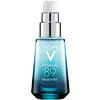What's inside
What's inside
 Key Ingredients
Key Ingredients

 Benefits
Benefits

 Concerns
Concerns

 Ingredients Side-by-side
Ingredients Side-by-side

Water
Skin ConditioningButylene Glycol
HumectantPropanediol
SolventMaltodextrin
AbsorbentCarbomer
Emulsion StabilisingPhenoxyethanol
PreservativeHydroxyacetophenone
AntioxidantHelianthus Annuus Seed Oil
EmollientGlycerin
HumectantSodium Polyacrylate
AbsorbentLespedeza Capitata Extract
Skin ConditioningPentylene Glycol
Skin ConditioningDisodium EDTA
Sodium Acetylated Hyaluronate
HumectantSodium Hydroxide
BufferingLactic Acid
BufferingSerine
MaskingSodium Lactate
BufferingSorbitol
HumectantUrea
BufferingRhizobian Gum
Sodium Hyaluronate
HumectantPadina Pavonica Thallus Extract
Skin ConditioningChlorphenesin
AntimicrobialPlankton Extract
Skin ConditioningChlorella Vulgaris Extract
Skin ConditioningSodium Chloride
MaskingCoenochloris Signiensis Extract
Skin ConditioningLecithin
EmollientTocopherol
AntioxidantAllantoin
Skin ConditioningWater, Butylene Glycol, Propanediol, Maltodextrin, Carbomer, Phenoxyethanol, Hydroxyacetophenone, Helianthus Annuus Seed Oil, Glycerin, Sodium Polyacrylate, Lespedeza Capitata Extract, Pentylene Glycol, Disodium EDTA, Sodium Acetylated Hyaluronate, Sodium Hydroxide, Lactic Acid, Serine, Sodium Lactate, Sorbitol, Urea, Rhizobian Gum, Sodium Hyaluronate, Padina Pavonica Thallus Extract, Chlorphenesin, Plankton Extract, Chlorella Vulgaris Extract, Sodium Chloride, Coenochloris Signiensis Extract, Lecithin, Tocopherol, Allantoin
 Reviews
Reviews

Ingredients Explained
These ingredients are found in both products.
Ingredients higher up in an ingredient list are typically present in a larger amount.
Carbomer is a polymer of acrylic acid. Its main role is to create a gel consistency.
A high amount of carbomer can cause pilling or balling up of products. Don't worry, most products contain 1% or less of carbomer.
Chlorella Vulgaris Extract comes from a green microalga. It is hydrating and contains antioxidants.
Studies also show Chlorella Vulgaris may help in rebuilding collagen and elastin. This ingredient is made up of lipids, carbohydrates, and chlorophyll.
Fun fact: This ingredient is commonly used as food additive in Japan.
Learn more about Chlorella Vulgaris ExtractGlycerin is already naturally found in your skin. It helps moisturize and protect your skin.
A study from 2016 found glycerin to be more effective as a humectant than AHAs and hyaluronic acid.
As a humectant, it helps the skin stay hydrated by pulling moisture to your skin. The low molecular weight of glycerin allows it to pull moisture into the deeper layers of your skin.
Hydrated skin improves your skin barrier; Your skin barrier helps protect against irritants and bacteria.
Glycerin has also been found to have antimicrobial and antiviral properties. Due to these properties, glycerin is often used in wound and burn treatments.
In cosmetics, glycerin is usually derived from plants such as soybean or palm. However, it can also be sourced from animals, such as tallow or animal fat.
This ingredient is organic, colorless, odorless, and non-toxic.
Glycerin is the name for this ingredient in American English. British English uses Glycerol/Glycerine.
Learn more about GlycerinPhenoxyethanol is a preservative that has germicide, antimicrobial, and aromatic properties. Studies show that phenoxyethanol can prevent microbial growth. By itself, it has a scent that is similar to that of a rose.
It's often used in formulations along with Caprylyl Glycol to preserve the shelf life of products.
Propanediol is an all-star ingredient. It softens, hydrates, and smooths the skin.
It’s often used to:
Propanediol is not likely to cause sensitivity and considered safe to use. It is derived from corn or petroleum with a clear color and no scent.
Learn more about PropanediolSodium Hyaluronate is hyaluronic acid's salt form. It is commonly derived from the sodium salt of hyaluronic acid.
Like hyaluronic acid, it is great at holding water and acts as a humectant. This makes it a great skin hydrating ingredient.
Sodium Hyaluronate is naturally occurring in our bodies and is mostly found in eye fluid and joints.
These are some other common types of Hyaluronic Acid:
Learn more about Sodium HyaluronateWater. It's the most common cosmetic ingredient of all. You'll usually see it at the top of ingredient lists, meaning that it makes up the largest part of the product.
So why is it so popular? Water most often acts as a solvent - this means that it helps dissolve other ingredients into the formulation.
You'll also recognize water as that liquid we all need to stay alive. If you see this, drink a glass of water. Stay hydrated!
Learn more about Water